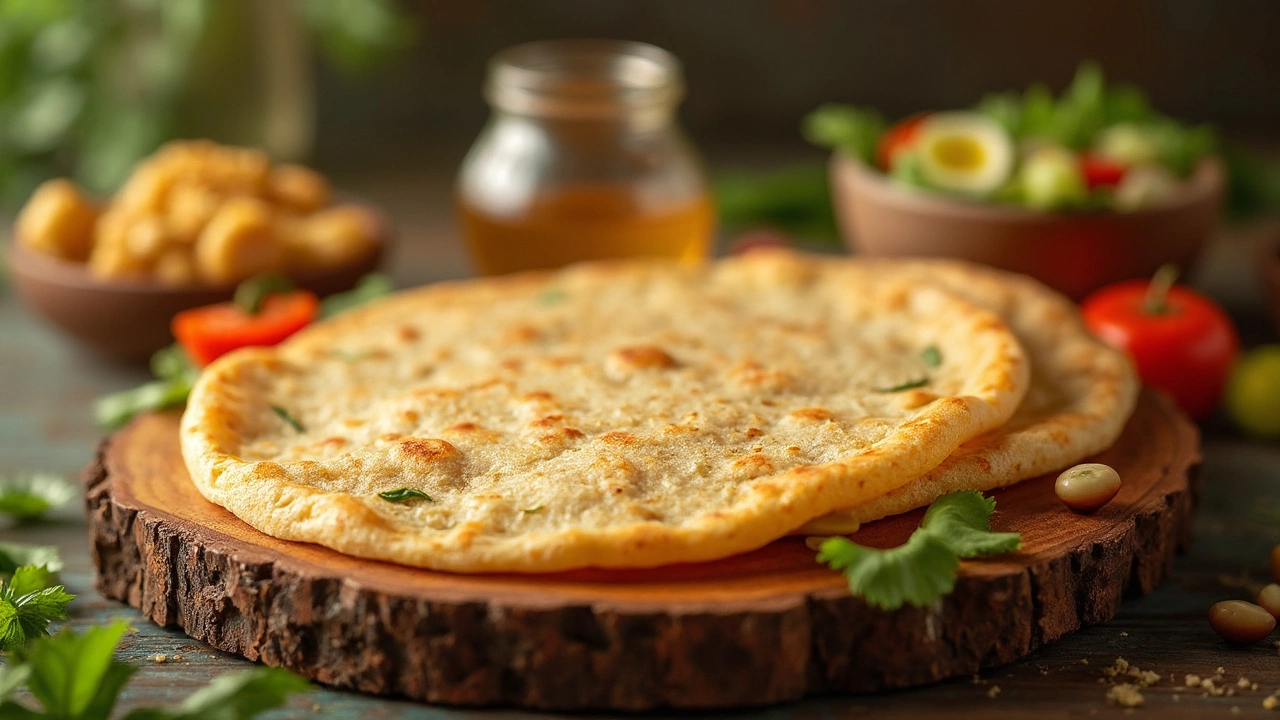How to Make a Healthier, Lower-Calorie Roti
 Feb, 24 2025
Feb, 24 2025
Ever wondered how to enjoy a delicious roti without feeling guilty about the calories? You're in the right place! Knowing how much calories in 1 roti can help you make mindful eating choices without giving up on taste.
A typical roti has around 70 to 120 calories, depending on the size and ingredients used. If you're pairing it with sabzi, the calories in 1 roti and sabzi can add up quickly, making it essential to make some tweaks for a healthier option.
Thinking about slathering some ghee on it? That buttery goodness increases its calorie count to about 125 calories. So, how do we keep it low-cal without compromising on flavor? Stay tuned for practical tips and tricks to transform your daily roti into a health booster!
- Understanding Roti Calories
- Choosing the Right Flour
- Incorporating Fiber
- Using Less Oil or Ghee
- Portion Control Tips
- Creative Roti Alternatives
Understanding Roti Calories
Roti, the beloved staple in many households, can sneak in more calories than we might think. So, let's break it down. The calories in 1 roti range from about 70 to 120, depending mainly on its size and how it's prepared. For those made with whole wheat flour (the most common type), you're looking at the lower end of that range.
But what about when you add a delightful spread of ghee? The calories in 1 roti with ghee jump to about 125 calories. Those tiny tweaks can increase that calorie count more than expected.
Factors Influencing Roti Calories
Two main factors influence the calorific value of your roti:
- Type of Flour: While traditional whole wheat flour is the norm, some prefer using refined flour, which generally gives a softer texture but adds more calories.
- Cooking Method: Cooking with oil or ghee can increase the calorie load significantly, especially if generously applied. Consider dry-roasting or using a non-stick tawa to keep it light.
Now, what happens when roti pairs with sabzi? The calories in 1 roti and sabzi combo rise, depending on the sabzi's ingredients and cooking style. An average serving could reach up to 200 to 250 calories, primarily influenced by the use of oils and cream in the sabzi.
Solution: Smart Swaps
Here's a simple fix: swap or tweak a few ingredients. Easier than you thought, right?
- Whole Grains: Opt for whole grain flour or mix some oats or millet. These not only lower the calorie count but add fiber.
- Sensibility with Ghee: Instead of using a full spoon of ghee, brush a little or use a spray for that rich taste minus the extra calories.
- Control the Size: Try smaller roti sizes. It's a simple hack to manage your portion without feeling deprived.
Understanding these subtle differences lets you enjoy your favorite roti with a bit more awareness and a pinch less guilt.
Choosing the Right Flour
Choosing the right flour is a game-changer when you're trying to make a healthier, lower-calorie roti. Not all flours are created equal, and some pack a more nutritional punch than others. Let's break it down!
Whole Wheat vs. White Flour
Whole wheat flour is your best bet for a nutritious roti. It's rich in fiber and keeps you feeling full longer, which is great if you're counting calories in 1 roti. In contrast, white flour is processed and stripped of essential nutrients.
Experimenting with Mixed Flours
If you want to boost nutrition, mix whole wheat flour with other flours.
- Bajra (Pearl Millet) Flour: High in protein and good for digestion. Mix in a bit to lower the overall calories in 1 roti.
- Jowar (Sorghum) Flour: Low in gluten and good for those who are gluten-sensitive. Jowar keeps the calorie count in check while offering a nutritious option.
- Besan (Chickpea) Flour: Adds protein and creates a rich texture. It's excellent if you want to lower calorie intake without compromising on taste.
A simple switch in ingredients can make a world of difference. So, next time you're making roti, try these alternatives and keep those calories in 1 roti lower while still enjoying your meal!
Incorporating Fiber
Trying to cut down on calories without sacrificing fullness? Incorporating fiber into your roti is a great way to do just that. Not only does fiber help you feel full longer, but it also aids digestion. Let’s dig into some simple swaps you can make to pack your roti with more fiber.
Choose Whole Grain or Multigrain Flour
Instead of the regular refined flour, opt for whole grain flour like whole wheat, jowar, or bajra. These are not only higher in fiber but also bring more nutrients to your meal. This means fewer calories in 1 roti since you're more likely to eat less quantity because of the increased satiety.
Add Flaxseeds or Chia Seeds
Mixing in a tablespoon of ground flaxseeds or chia seeds with your flour can boost your roti's fiber content significantly. Flaxseeds and chia seeds are packed with omega-3 fatty acids, which are great for heart health.
Include Veggies in the Dough
Grate vegetables like carrots, spinach, or methi into your dough. This will not only improve the fiber content, but also add a nice flavor and texture to your roti. Plus, it’s a sneaky way to get the kids to eat more veggies!
Step-by-Step Fiber Boost
- Start with your regular dough preparation but switch the refined flour for whole wheat or another high-fiber alternative.
- Add in a tablespoon of ground flaxseeds or chia seeds and mix well.
- If you like, incorporate grated vegetables right into the dough.
- Prepare the dough as usual, and cook the roti on a preheated tawa without oil or ghee to keep it low-calorie.
Fiber Content Table
| Ingredient | Fiber (per 100g) |
|---|---|
| Whole Wheat Flour | 12.5g |
| Chia Seeds | 34.4g |
| Flaxseeds | 27.3g |
Making these changes means you're not just reducing calories in 1 roti, but also boosting its nutritional profile. It’s a win-win situation for your taste buds and waistline!

Using Less Oil or Ghee
Who doesn't love the rich, nutty flavor of ghee melting on a fresh roti? But, adding ghee can bump up the calories in 1 roti with ghee. Here's the good news: you can enjoy delicious rotis without overloading on calories. Let's dive into how.
Why Reduce Oil or Ghee?
Ghee, while tasty, contributes significant calories. Using too much can quickly increase the overall caloric content of your meal. By reducing the oil or ghee, you're making room for more nutrient-dense foods without packing on extra calories.
Steps to Cut Down Oil or Ghee in Your Roti
- Start Small: Gradually decrease the amount of ghee or oil you use. Instead of a tablespoon, try a teaspoon or less. You'll adjust and still enjoy that buttery flavor.
- Alternative Spreads: Swap ghee for healthier fats like olive oil or just a brush of coconut oil for a change.
- Use Cooking Spray: A quick spray on your pan before cooking can reduce calories without sacrificing taste.
- Knead with Milk: For that soft texture, consider kneading the dough with milk or unsweetened yogurt. This adds flavor and softness without relying on oil.
Smart Alternatives
Try experimenting with your rotis by adding seeds or spices during preparation. Flaxseeds or chia seeds not only boost nutrition but also add a crunchy texture, making you forget the extra ghee.
Make it a Habit
Consistently using less oil or ghee, combined with creative alternatives, will lower the calories in 1 roti and promote healthier eating habits. You'll still enjoy your meals but with a lighter, guilt-free twist.
Portion Control Tips
Managing portion sizes can be a game-changer if you're aiming to enjoy roti without piling on too many calories. The good news? It's simpler than you think. Let's dive into some practical tips!
Start with Smaller Rotis
If you're used to making large rotis, consider downsizing. A smaller roti means fewer calories without cutting down on number or frequency. Try using less dough while rolling it out.
Stick to One Roti per Meal
This one's straightforward: limit yourself to one roti per meal. Add more nutrients to your meal by pairing it with a generous helping of veggies or a protein-rich side.
"Balancing portion size and meal composition can significantly enhance the nutritional value of your daily diet." – Nutrition Expert, Meera Bakshi
Slow Eating Can Help
Savor each bite, chewing slowly. Giving your brain time to register fullness can prevent overeating. Plus, you'll enjoy the flavors more.
Feel Full with Fiber
Enhance your meal's volume by adding a fiber-rich salad or healthy soup. It helps keep you satisfied so one roti feels like a feast.
Track Your Intake
If you're unsure about how much to eat, try maintaining a food diary for a week. It’ll give you insights into your eating habits. Apps like MyFitnessPal can help track how much calories in 1 roti you’re consuming.
| Roti Size | Calories |
|---|---|
| Small (4-inch) | 70 |
| Medium (6-inch) | 85 |
| Large (8-inch) | 120 |
With these simple changes, enjoying a healthy, balanced meal is totally doable. Keep experimenting and find what best suits your lifestyle and preferences!
Creative Roti Alternatives
Let's face it, sometimes you want to switch things up without saying goodbye to your beloved roti. Creating lighter versions or trying out new twists can reduce the caloric load while ensuring that every bite is as delightful as ever!
1. Multigrain Roti
Mixing grains like oats, barley, or millet can make your roti healthier. Multigrain flour has a lower glycemic index, keeping you full for longer and helping in weight management. Simply mix equal parts of these flours with whole wheat flour to start.
2. Spinach or Methi Roti
Need a nutrition boost? Add puréed spinach or fenugreek leaves (methi) into your dough. Not only do you get extra fiber and vitamins, but you also enjoy vibrant color and flavor. Kids love them because they're like superhero food!
3. Cauliflower Roti
Replace some flour with grated cauliflower for a low-carb alternative. Squeeze out excess moisture and mix it into your dough. It cuts down the calories in 1 roti significantly while sneaking in a veggie portion!
4. Sweet Potato Roti
If you're craving something different, try incorporating boiled sweet potatoes into your dough. They're naturally sweet, making your roti a delightful sidekick to any spicy dish. Rich in fiber, sweet potatoes balance out the savory flavors of your meal while offering essential nutrients.
5. Bean Tortilla Roti
This twist on traditional roti uses black bean flour. High in protein and fiber, this alternative is perfect for those looking to add more plant-based nutrition to their meals. Plus, it's naturally gluten-free!
6. Flaxseed Roti
Boost your omega-3 intake by adding ground flaxseeds to your dough. Flaxseeds are an excellent source of healthy fats and can enhance the nutritional profile of your roti with minimal changes in taste.
Exploring these options not only diversifies your diet but also often means fewer calories in 1 roti, making them perfect for conscious eaters eager to explore new flavors. So, why not have a little fun and experiment with these creative alternatives? Grab your apron, and let's get rolling!